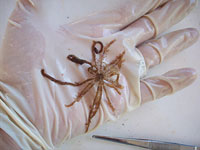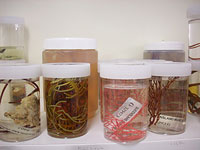

 | |||||||||||||
|
|
Journals 2008/2009Zamaria Rocio
September 5, 2008 I had two coral heads to work up today. While processing one of the coral heads, I came across an usual creature that was both pretty but weird looking. It was called a tongue worm, Echiura. Some features of this unsegmented worm were its proboscis that was bi-lobed, it was a burrowing animal and that it ingested sediments. Here is a photograph of it under a dissecting microscope. 
Another find I had was the feather star. These filter feeders are Crinoids. Coming out of the small center disc of their body are arms that look feathery. They also have specialized appendages on the underside called cirri, which helps them cling unto coral heads. They are mostly nocturnal. 
Today I also had time to help out another group of scientist working here. It was the soft coral group. All three of these scientists were from the Queensland Museum. Soft coral (order Alcyonacea) belong to the subclass Octocorallia. These would include gorgonian corals, sea pens, sea pansies, and the organ-pipe corals. The soft coral polyps have eight side-branching tentacles that surround their mouth and they live in colonies. If you were to touch them, they would feel jelly-like. Soft corals usually sway in the ocean's current and sieve their food. Compared to the hard reef corals, the soft corals grow faster. The scientists had me looking at the soft corals' calcareous spicules. These are needle-shaped structures that help give some of these corals their color. By also using these spicules they can determine what species of soft corals they are.
This groups had all went on many dives and brought back a lot of samples. They would document and take tissue samples. They made wet-mount slides of the tissue samples and preserved the rest of it in labeled jars. 
|
||||||||||||

